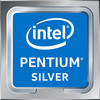Intel Pentium Silver J5040

The Intel Pentium Silver J5040 is a quad-core SoC primarily for inexpensive mini-PCs and was announced late 2019. It runs at 2 GHz (base) to 3.2 GHz (single core burst) and is based on the Gemini Lake platform (refresh). Similar to the Apollo Lake predecessor, the chip is manufactured in a 14 nm process with FinFETs but offers slightly improved processor cores, double the amount of L2 cache, a smaller package, a better GPU architecture and a partly integrated WiFi support. Besides four CPU cores, the chip also includes a DirectX 12 capable GPU as well as a DDR4/LPDDR4 memory controller (dual-channel, up to 2400 MHz). The SoC is not replaceable as it is directly soldered to the mainboard.
Architecture
The processor architecture is still called Goldmont Plus. Compared to the older Goldmont cores in Apollo Lake, they feature an increased level 2 cache (to 4 MB). That means the per-clock-performance should be a bit better, but not near the Core CPUs like Kaby Lake Y.
Performance
Thanks to the higher clock speed and TDP, the Pentium J5040 is slightly faster than the mobile counterpart, the Pentium Silver N5030. Compare to AMD, it ranks on average slightly higher compared to the Athlon Silver 3050e (Zen based Dual-Core) that wins in single-core tests but looses out in multi-threaded tests. Intel Core i3 from 2019 (like the i3-1005G1) are clearly faster and win even in multi-threaded tests easily although being only dual-core CPUs.
GPU Performance
The UHD Graphics 605 (Gemini Lake) is based on Intel's Gen9 architecture, which supports DirectX 12 and is also used for the Kaby Lake / Skylake / Apollo Lake graphics adapters (like HD Graphics 520). Equipped with 18 EUs and a clock of up to 800 MHz, the performance should be roughly on par with the older HD Graphics 5300 and HD Graphics 505 (Apollo Lake).
The chip also includes an advanced video engine with hardware support for the playback of VP9 and H.265 material (8-bit color-depth).
Power Consumption
The J-variant of the Gemini Lake SoCs are specified at 10W TDP and therefore higher than the mobile N variants (6 Watt).
| Codename | Gemini Lake Refresh | ||||||||||||||||||||||||
| Series | Intel Gemini Lake | ||||||||||||||||||||||||
Series: Gemini Lake Gemini Lake Refresh
| |||||||||||||||||||||||||
| Clock Rate | 2000 - 3200 MHz | ||||||||||||||||||||||||
| Level 2 Cache | 4 MB | ||||||||||||||||||||||||
| Number of Cores / Threads | 4 / 4 | ||||||||||||||||||||||||
| Power Consumption (TDP = Thermal Design Power) | 10 Watt | ||||||||||||||||||||||||
| Manufacturing Technology | 14 nm | ||||||||||||||||||||||||
| Max. Temperature | 105 °C | ||||||||||||||||||||||||
| Socket | FCBGA1090 | ||||||||||||||||||||||||
| Features | Intel UHD Graphics 605 (18 EUs, 200 - 750 MHz), Quick Sync, AES-NI, max. 8 GB Dual-Channel DDR4/LPDDR4-2400 | ||||||||||||||||||||||||
| GPU | Intel UHD Graphics 605 (250 - 800 MHz) | ||||||||||||||||||||||||
| 64 Bit | 64 Bit support | ||||||||||||||||||||||||
| Architecture | x86 | ||||||||||||||||||||||||
| Announcement Date | 11/04/2019 | ||||||||||||||||||||||||
| Product Link (external) | www.intel.com | ||||||||||||||||||||||||
Benchmarks
* Smaller numbers mean a higher performance
No reviews found for this CPU (yet).













